Interviews
 |
 |
 |
 |
 |
 |
 |
Q & A on Fashion
Catholic Imagery in Today’s Fashions
Firstly, my name is C.B. I stumbled across your website whilst searching for some articles related to fashion and religion and found yours on the Gaultier collection called "Blasphemy against the Most Holy Virgin Mary in the Spring 2007 Fashion Collection by Gaultier."
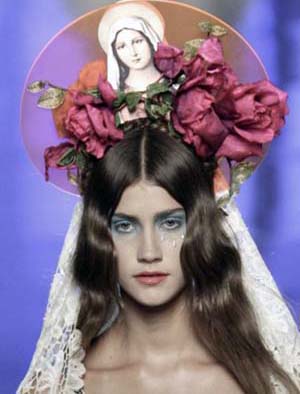
From the Gaultier Madonna collection
I have been searching for secondary research, however, in order to get the best possible marks and most useful information I am hoping to get as much primary research as possible. This is where I thought you could be a huge help !
If I could, would it be possible for me to email you some questions like a mini interview to get your opinion more in depth on the matter? It would be so extremely helpful for my essay and I would really appreciate it. I understand if you do not wish to take part - I am aware that you are against the use of religion within fashion and I am in no way saying I support it, the purpose of my essay is simply to explore and debate the matter.
Thank you very much and I look forward to hearing from you soon !
Regards,
C.B.
1. What impact does the portrayal of religious imagery in fashion have on the Catholic Faith?
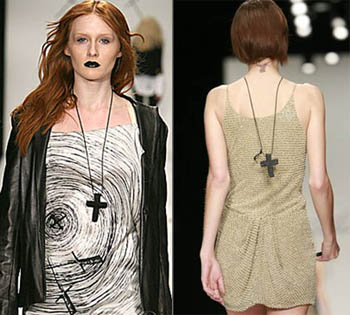
The Imitation of Christ Collection makes profane use of the cross
We can judge the impact of such imagery by the reaction of concerned Catholics in countries that still maintain standards of decency. For example, when previews of Policegirl starring scantily clad star Kavitta Verma wearing a Rosary around her neck with the cross positioned over her nude belly were shown in Mumbai, India, a concerned NGO, Catholic Secular Forum (CSF), strongly protested.
CSF spokesman Joseph Dias rightly called the use of the Rosary in this scene “blasphemous” and an insult to the Mother of God as well as to all Catholics who pray the Rosary. He also threatened to initiate criminal proceedings against the makers of the movie, asserting the promo pictures wounded the religious sentiments of the entire Catholic community around the world. (1)
Responding to the strong protest, the movie’s producer assured Catholics the objectionable scene would not be shown.
I believe this kind of healthy reaction from the Catholic public comes from a just outrage and indignation that arises precisely because such portrayals are viewed as attacks that affront and impact the Catholic Faith.
2. Is the use of religious imagery for adornment purposes against the teachings of the Catholic Church? Why?
Religious imagery – medallions, medals, crosses, badges, etc. – has a long history of use to adorn the dress of Catholics. In the religious sphere, the habits of men and women religious always had some form of religious symbol – a medal, badge, cross, even the 15-decade Rosary that hung from cinctures, to name a few.
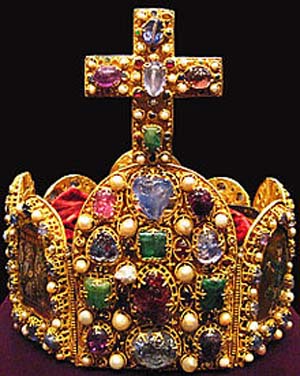
The Imperial Crown adorned by a cross
In the secular sphere, from the early Middle Ages Catholic monarchs also began to wear religious imagery as a sign of their respect and love for the Faith. For example, the Imperial Crown of the Holy Roman German Empire, which dates from the late 10th century, has a jeweled crown atop it, a symbol that above the Emperor was Christ. King Alphonsus of Leon and Galicia became known for wearing a Rosary on his belt to encourage his subordinates to embrace this devotion.
The common people, following the example of the religious, kings and nobles, also adopted the custom of wearing religious imagery such as adorned crosses, medals, etc. The Church encouraged this practice by granting papal blessings and even special indulgences to various devotional medals –particularly the Miraculous Medal – scapulars, and small pectoral crosses. While the purpose of wearing such imagery was primarily religious – to honor Our Lord, the Virgin Mary or the various Saints – a secondary and acceptable purpose was for adornment. Beautiful objects give glory to God, thus also beautiful religious imagery.
Unacceptable imagery
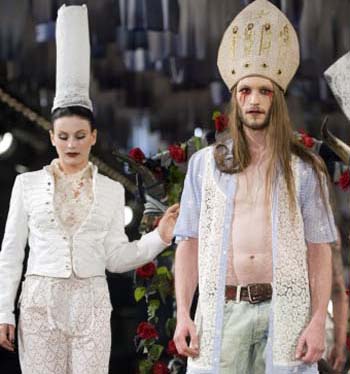
At the German fashion fair, the 'Denim Religious' Show openly mocked the Catholic hierarchy
Blasphemy, from the Greek plaptein, ‘to injure,’ and pheme, ‘reputation,’ signifies etymologically gross irreverence or indecorous behavior towards any person or thing worthy of exalted esteem. It is condemned because it denotes derogation of the honor due to God.
Today, we find more and more examples of religious imagery being displayed or used in a blasphemous manner. For example, we have the blasphemous and immoral representations of the Blessed Virgin Mary in the Spring Fashion Collection by French couturier Jean Paul Gaultier, reviewed by author Atila Guimarães on our Tradition in Action website.
As Guimarães notes, the immodest dresses and bold posturing of the models are indisputable blasphemies against the Virgin Mary and an insult to all Catholics who honor her as the Mother of God.
3. Does the use of religious imagery in fashion have an impact on society’s perception of the Catholic Faith? If so, is this in a positive or negative way?
Since the fashion industry today is using religious imagery to adorn immoral clothing or as part of the vulgar and irreverent pop culture, I believe that it has a strong negative impact on society’s perception of the Faith.
Let us look, for example, at the use of the Rosary. The Church does not condemn the wearing of the Rosary and has even in the past offered indulgences to those who openly wear it out of devotion and to set a good example to others. Unfortunately, neither of these intentions are taken into consideration in the modern use of the Rosary.
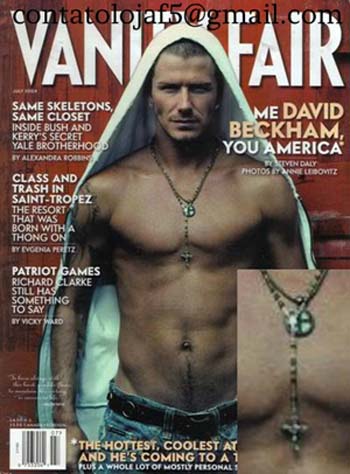
Above, David Beckham, below, members of Black Sabbath band
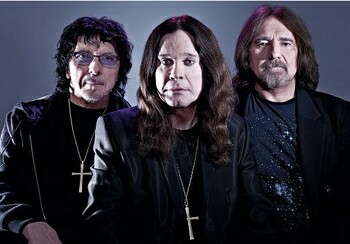
This profane use of religious symbols obviously has a deleterious effect on religion. It de-sacralizes the very serious and beautiful prayer of the Rosary loved by Catholics around the world. In these cases, the Rosary has not been used by devotion, but in a superstitious way as an amulet or even in tune with the blasphemous fashions set by Satanic Heavy Metal bands such as Black Sabbath.
Wearing the Rosary with inappropriate clothing and blasé attitude has become so prevalent that some Catholic authorities have expressed “regret” about the way the Rosary beads are being trivialized. In March 2014 the Bishops’ Conference of England and Wales issued guidelines for its use strictly for prayer and not adornment.(2) Such a reproof, however, is very light, in my opinion, given the grievance of the offense.
If the Catholic Prelates would speak forcefully against this abuse of sacral objects and ask for acts of reparation for such inappropriate or blasphemous displays, the laity would be awakened to the seriousness of the offense.
In the past, special prayers and devotions, included in the Raccolta Catholic prayer book, were disseminated to be said as acts of reparation for blasphemies. There are even Pontifical Congregations specifically turned toward making reparation for blasphemy, such as the Pontifical Congregation of the Benedictine Sisters of the Reparation of the Holy Face.
Unfortunately, after Vatican Council II, such prayers and Institutes are disappearing, being reformed or replaced by others instructed to tolerate almost all the blasphemies of today’s world.
4. What age group of people do you think would be most offended by the use of religious imagery in fashion? 16-25; 26-39; 40-59; 60+
I believe, in general, the conservative element of the 60+ group would tend to be more offended at the present day use of religious imagery in fashion and consider it blasphemous. However, there are an increasing number of traditionalist Catholics in all these age groups who strongly react against blasphemies.
5. Do you think there could be any positive outcomes from Catholic designers using their faith as inspiration behind their collections?
Clearly there would be positive outcomes if Catholic designers would follow Catholic morals and tradition in designing their collections. Fashions would become more modest, women’s dress would be more feminine, and masculine clothing more manly and less extravagant.
Proof of the importance the Church always gave to fashion is a speech delivered by Pope Pius XII to the International Congress of Master Dressmakers on September 10, 1954. In it he affirms their role to tailor clothing acceptable to Catholic morals.
He told the dressmakers:
“Instead of elevating and ennobling the human person, [today’s] clothing tends to degrade and debase it. Even if you are not responsible for these regrettable manifestations, you cannot remain indifferent to them. Far from maintaining the already too strong inclination toward immodesty, always be careful to respect the norms of decency and good taste, of a sanely understood and perfectly honest elegance.
“In brief, instead of following the materialistic current that is leading so many people astray today, deliberately put yourselves at the service of spiritual ends.”
6. In your opinion, which is the stronger and more influential institution: religion or fashion? Why?
When religion is strong and sound, as it was in the Middle Ages when it shaped Christian Civilization, its influence touches every sphere of life, including fashion, creating charming and diverse costumes that correspond to the various social levels of the people.
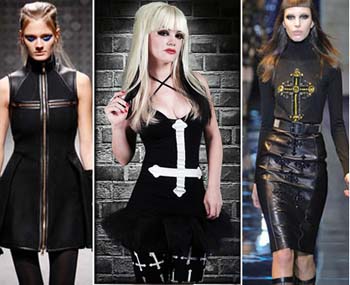
Use of crosses to favor the occult
However, were religion to recover its integrity and vitality, as it has in many Catholic traditional and conservative milieus, then we see that the fashions, styles and customs tend to become more modest and sound, in accordance with Catholic morals.
Therefore, the answer to your question is: the Church is stronger as an institution, as we can clearly see when she has the courage to exercise her influence on dress, as Pius XII did.
7. We have seen Madonna use lots of Catholic imagery circa the ‘80s, now Lady Gaga. Are pop icons the way forward in spreading the beliefs and views of religion?
Madonna’s use of religious imagery is a self-admitted rebellion against her Catholic religious heritage. She does not hesitate to use religious symbols in a blasphemous way.
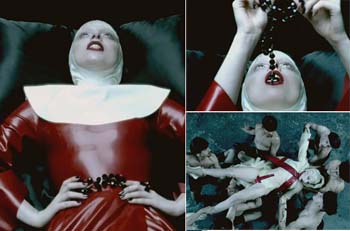
Lady Gaga's blasphemous use of Catholic images and symbols
The same tendency can be verified in dressing. For example, supermodel Miranda Kerr posed for a European fashion magazine Numero sensually embracing a woman dressed as a nun.
Hollywood is not behind this trend: “Dancing with the Stars” contestant Joanna Krupa starred in a PETA campaign posing naked in a church, holding a crucifix to cover her private parts.
Instead of spreading the beliefs and views of Religion, these actions encourage the opposite, scorn and ridicule of Catholicism.
8. What are your opinions on this Dolce and Gabbana ad campaign?
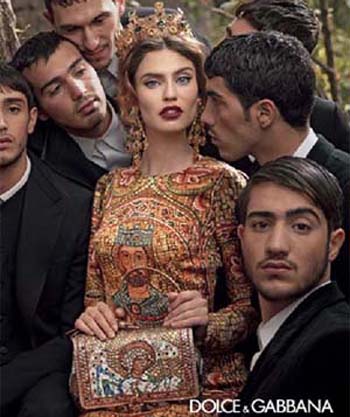
The model - with abnormally plump beet red lips and a blank frozen stare - wears a dress with a Byzantine icon of Christ the King. On her purse is another icon, which seems to be of the Virgin Mary.
While the dress, as seen in this photo, is not particularly immodest, the pose of the a sensuous ‘queen’ surrounded by a group of hopeful lovers who gaze lustfully at her, suggests immoral behavior and, as such, is scandalous.
What is the message such a picture sends? That a woman who wears blasphemous dresses attracts male attention. Once again, it is a bad message from a designer that offends the sensibilities of Catholics and puts down religious imagery.
- “Christians object to rosary-on-belly scene in Policegirl”, IndiaToday online, June 14, 2013
- “Rosary is not just a fashion item, explains Church,” The Telegraph online, March 28, 2014
Posted April 4, 2014
______________________
______________________





